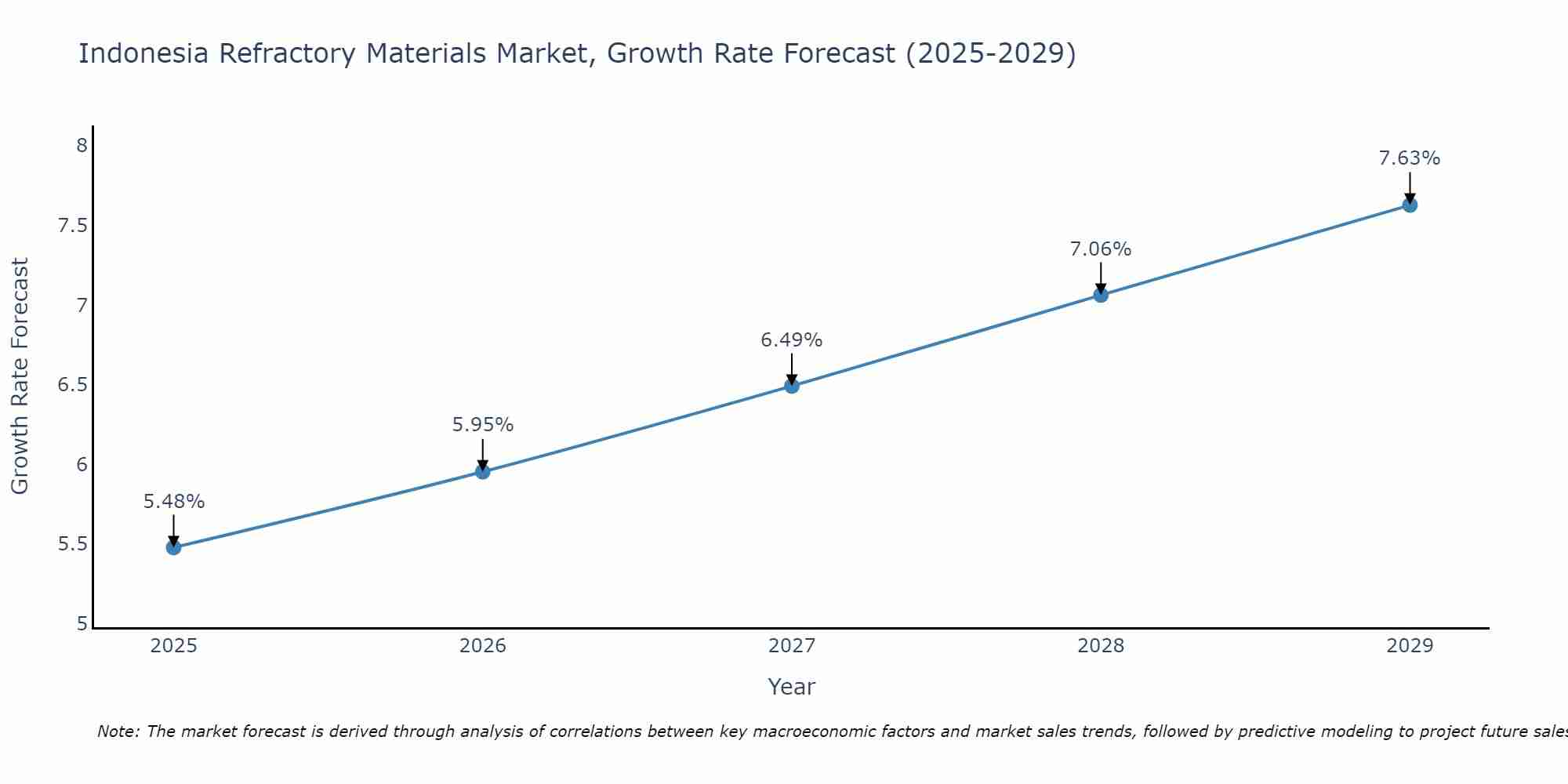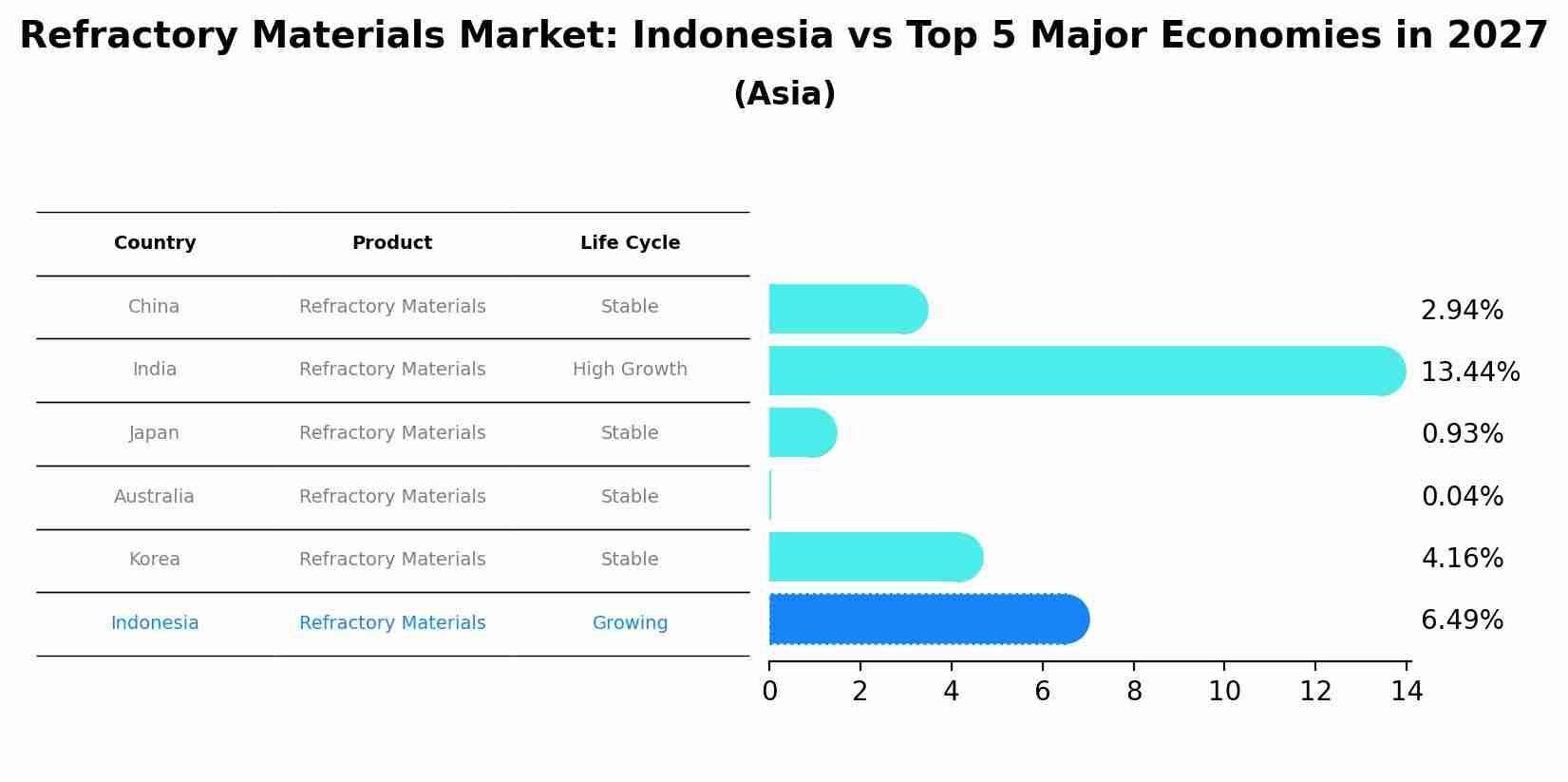Indonesia Refractory Materials Market (2024-2030) | Forecast, Companies, Value, Trends, Growth, Outlook, Analysis, Size, Industry, Revenue & Share
| Product Code: ETC033648 | Publication Date: Jul 2023 | Updated Date: Aug 2025 | Product Type: Report | |
| Publisher: 6Wresearch | Author: Ravi Bhandari | No. of Pages: 70 | No. of Figures: 35 | No. of Tables: 5 |
Indonesia Refractory Materials Market Size Growth Rate
The Indonesia Refractory Materials Market is poised for steady growth rate improvements from 2025 to 2029. Commencing at 5.48% in 2025, growth builds up to 7.63% by 2029.

Refractory Materials Market: Indonesia vs Top 5 Major Economies in 2027 (Asia)
In the Asia region, the Refractory Materials market in Indonesia is projected to expand at a growing growth rate of 6.49% by 2027. The largest economy is China, followed by India, Japan, Australia and South Korea.

Indonesia Refractory Materials Market Synopsis
The Indonesia refractory materials market is anticipated to register a CAGR of 4.3% during theperiod (2020-2026). Refractories are materials used in industrial furnaces kilns incinerators and reactors exposed to high temperatures. Increasing steel production coupled with growing demand for energy conservation has been identified as one of the major drivers for Indonesia`s refractory materials market. The rising prices of raw material have also contributed towards an upsurge in demand for more efficient products such as alumina-silica bricks and carbon bonded magnesia chrome bricks due to their better performance at higher temperatures. Moreover growing investment in residential real estate developments by local government authorities is expected to create lucrative opportunities for the Indonesia refractoriesover theperiod.
Key Factors Driving the Market
Drivers boosting the marketare the growing steel production rising demand from energy conservation sectorsand growing investment in residential real estate development.
Key Highlights of the Report:
- Indonesia Refractory Materials Market Outlook
- Market Size of Indonesia Refractory Materials Market, 2023
- Forecast of Indonesia Refractory Materials Market, 2030
- Historical Data and Forecast of Indonesia Refractory Materials Revenues & Volume for the Period 2020-2030
- Indonesia Refractory Materials Market Trend Evolution
- Indonesia Refractory Materials Market Drivers and Challenges
- Indonesia Refractory Materials Price Trends
- Indonesia Refractory Materials Porter's Five Forces
- Indonesia Refractory Materials Industry Life Cycle
- Historical Data and Forecast of Indonesia Refractory Materials Market Revenues & Volume By Type for the Period 2020-2030
- Historical Data and Forecast of Indonesia Refractory Materials Market Revenues & Volume By Brick for the Period 2020-2030
- Historical Data and Forecast of Indonesia Refractory Materials Market Revenues & Volume By Monolithic for the Period 2020-2030
- Historical Data and Forecast of Indonesia Refractory Materials Market Revenues & Volume By Applications for the Period 2020-2030
- Historical Data and Forecast of Indonesia Refractory Materials Market Revenues & Volume By Clay Refractories for the Period 2020-2030
- Historical Data and Forecast of Indonesia Refractory Materials Market Revenues & Volume By Non-clay Refractories for the Period 2020-2030
- Indonesia Refractory Materials Import Export Trade Statistics
- Market Opportunity Assessment By Type
- Market Opportunity Assessment By Applications
- Indonesia Refractory Materials Top Companies Market Share
- Indonesia Refractory Materials Competitive Benchmarking By Technical and Operational Parameters
- Indonesia Refractory Materials Company Profiles
- Indonesia Refractory Materials Key Strategic Recommendations
Frequently Asked Questions About the Market Study (FAQs):
1 Executive Summary |
2 Introduction |
2.1 Key Highlights of the Report |
2.2 Report Description |
2.3 Market Scope & Segmentation |
2.4 Research Methodology |
2.5 Assumptions |
3 Indonesia Refractory Materials Market Overview |
3.1 Indonesia Country Macro Economic Indicators |
3.2 Indonesia Refractory Materials Market Revenues & Volume, 2020 & 2030F |
3.3 Indonesia Refractory Materials Market - Industry Life Cycle |
3.4 Indonesia Refractory Materials Market - Porter's Five Forces |
3.5 Indonesia Refractory Materials Market Revenues & Volume Share, By Type, 2020 & 2030F |
3.6 Indonesia Refractory Materials Market Revenues & Volume Share, By Applications, 2020 & 2030F |
4 Indonesia Refractory Materials Market Dynamics |
4.1 Impact Analysis |
4.2 Market Drivers |
4.2.1 Growing demand from industries such as steel, cement, and glass due to infrastructure development projects in Indonesia |
4.2.2 Increasing focus on improving energy efficiency and reducing emissions in industrial processes |
4.2.3 Rising investments in the manufacturing sector, leading to higher demand for refractory materials |
4.3 Market Restraints |
4.3.1 Fluctuating raw material prices impacting production costs |
4.3.2 Intense competition from low-cost imports affecting domestic refractory material manufacturers |
4.3.3 Challenges related to technical expertise and skilled labor in the refractory materials industry in Indonesia |
5 Indonesia Refractory Materials Market Trends |
6 Indonesia Refractory Materials Market, By Types |
6.1 Indonesia Refractory Materials Market, By Type |
6.1.1 Overview and Analysis |
6.1.2 Indonesia Refractory Materials Market Revenues & Volume, By Type, 2020-2030F |
6.1.3 Indonesia Refractory Materials Market Revenues & Volume, By Brick, 2020-2030F |
6.1.4 Indonesia Refractory Materials Market Revenues & Volume, By Monolithic, 2020-2030F |
6.2 Indonesia Refractory Materials Market, By Applications |
6.2.1 Overview and Analysis |
6.2.2 Indonesia Refractory Materials Market Revenues & Volume, By Clay Refractories, 2020-2030F |
6.2.3 Indonesia Refractory Materials Market Revenues & Volume, By Non-clay Refractories, 2020-2030F |
7 Indonesia Refractory Materials Market Import-Export Trade Statistics |
7.1 Indonesia Refractory Materials Market Export to Major Countries |
7.2 Indonesia Refractory Materials Market Imports from Major Countries |
8 Indonesia Refractory Materials Market Key Performance Indicators |
8.1 Energy efficiency improvement rate in industries using refractory materials |
8.2 Percentage increase in investments in the manufacturing sector |
8.3 Adoption rate of advanced refractory materials in key industries in Indonesia |
9 Indonesia Refractory Materials Market - Opportunity Assessment |
9.1 Indonesia Refractory Materials Market Opportunity Assessment, By Type, 2020 & 2030F |
9.2 Indonesia Refractory Materials Market Opportunity Assessment, By Applications, 2020 & 2030F |
10 Indonesia Refractory Materials Market - Competitive Landscape |
10.1 Indonesia Refractory Materials Market Revenue Share, By Companies, 2023 |
10.2 Indonesia Refractory Materials Market Competitive Benchmarking, By Operating and Technical Parameters |
11 Company Profiles |
12 Recommendations |
13 Disclaimer |
- Single User License$ 1,995
- Department License$ 2,400
- Site License$ 3,120
- Global License$ 3,795
Search
Thought Leadership and Analyst Meet
Our Clients
Related Reports
- Germany Breakfast Food Market (2026-2032) | Industry, Share, Growth, Size, Companies, Value, Analysis, Revenue, Trends, Forecast & Outlook
- Australia Briquette Market (2025-2031) | Growth, Size, Revenue, Forecast, Analysis, Trends, Value, Share, Industry & Companies
- Vietnam System Integrator Market (2025-2031) | Size, Companies, Analysis, Industry, Value, Forecast, Growth, Trends, Revenue & Share
- ASEAN and Thailand Brain Health Supplements Market (2025-2031) | Strategy, Consumer Insights, Analysis, Investment Trends, Opportunities, Growth, Size, Share, Industry, Revenue, Segments, Value, Segmentation, Supply, Forecast, Restraints, Outlook, Competition, Drivers, Trends, Demand, Pricing Analysis, Competitive, Strategic Insights, Companies, Challenges
- ASEAN Bearings Market (2025-2031) | Strategy, Consumer Insights, Analysis, Investment Trends, Opportunities, Growth, Size, Share, Industry, Revenue, Segments, Value, Segmentation, Supply, Forecast, Restraints, Outlook, Competition, Drivers, Trends, Demand, Pricing Analysis, Competitive, Strategic Insights, Companies, Challenges
- Europe Flooring Market (2025-2031) | Outlook, Share, Industry, Trends, Forecast, Companies, Revenue, Size, Analysis, Growth & Value
- Saudi Arabia Manlift Market (2025-2031) | Outlook, Size, Growth, Trends, Companies, Industry, Revenue, Value, Share, Forecast & Analysis
- Uganda Excavator, Crane, and Wheel Loaders Market (2025-2031) | Strategy, Consumer Insights, Analysis, Investment Trends, Opportunities, Growth, Size, Share, Industry, Revenue, Segments, Value, Segmentation, Supply, Forecast, Restraints, Outlook, Competition, Drivers, Trends, Demand, Pricing Analysis, Competitive, Strategic Insights, Companies, Challenges
- Rwanda Excavator, Crane, and Wheel Loaders Market (2025-2031) | Strategy, Consumer Insights, Analysis, Investment Trends, Opportunities, Growth, Size, Share, Industry, Revenue, Segments, Value, Segmentation, Supply, Forecast, Restraints, Outlook, Competition, Drivers, Trends, Demand, Pricing Analysis, Competitive, Strategic Insights, Companies, Challenges
- Kenya Excavator, Crane, and Wheel Loaders Market (2025-2031) | Strategy, Consumer Insights, Analysis, Investment Trends, Opportunities, Growth, Size, Share, Industry, Revenue, Segments, Value, Segmentation, Supply, Forecast, Restraints, Outlook, Competition, Drivers, Trends, Demand, Pricing Analysis, Competitive, Strategic Insights, Companies, Challenges
Industry Events and Analyst Meet
Whitepaper
- Middle East & Africa Commercial Security Market Click here to view more.
- Middle East & Africa Fire Safety Systems & Equipment Market Click here to view more.
- GCC Drone Market Click here to view more.
- Middle East Lighting Fixture Market Click here to view more.
- GCC Physical & Perimeter Security Market Click here to view more.
6WResearch In News
- Doha a strategic location for EV manufacturing hub: IPA Qatar
- Demand for luxury TVs surging in the GCC, says Samsung
- Empowering Growth: The Thriving Journey of Bangladesh’s Cable Industry
- Demand for luxury TVs surging in the GCC, says Samsung
- Video call with a traditional healer? Once unthinkable, it’s now common in South Africa
- Intelligent Buildings To Smooth GCC’s Path To Net Zero


















